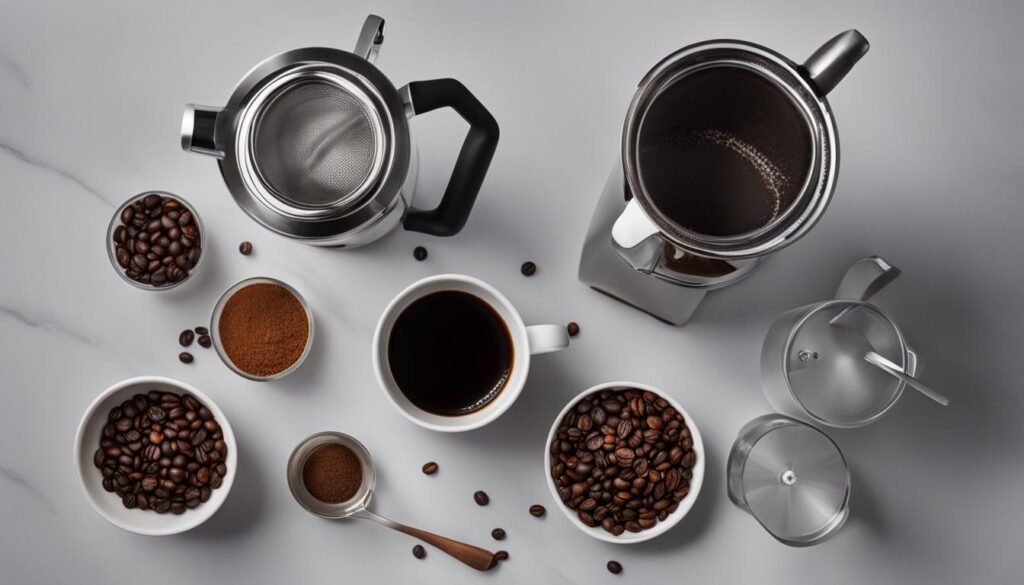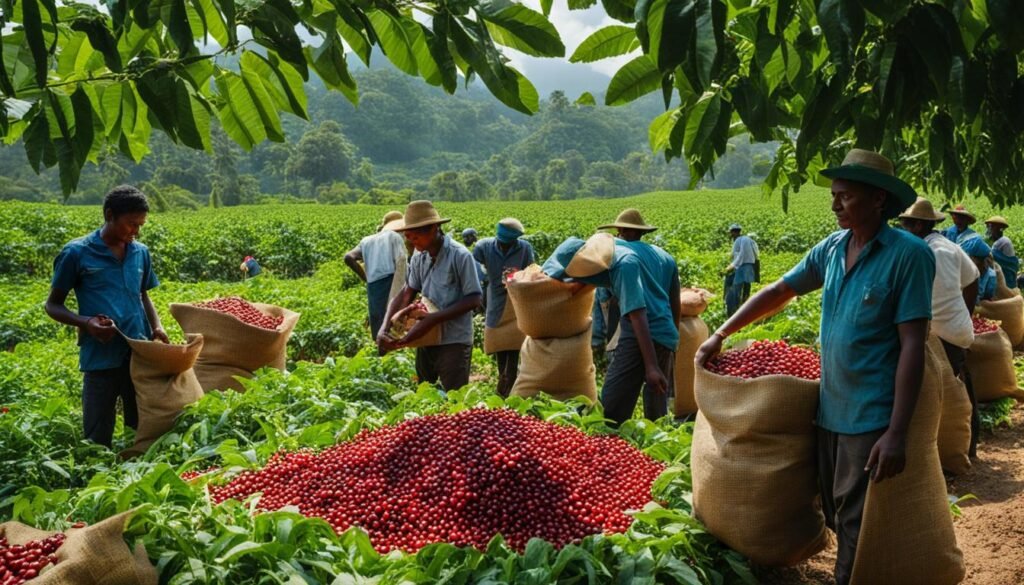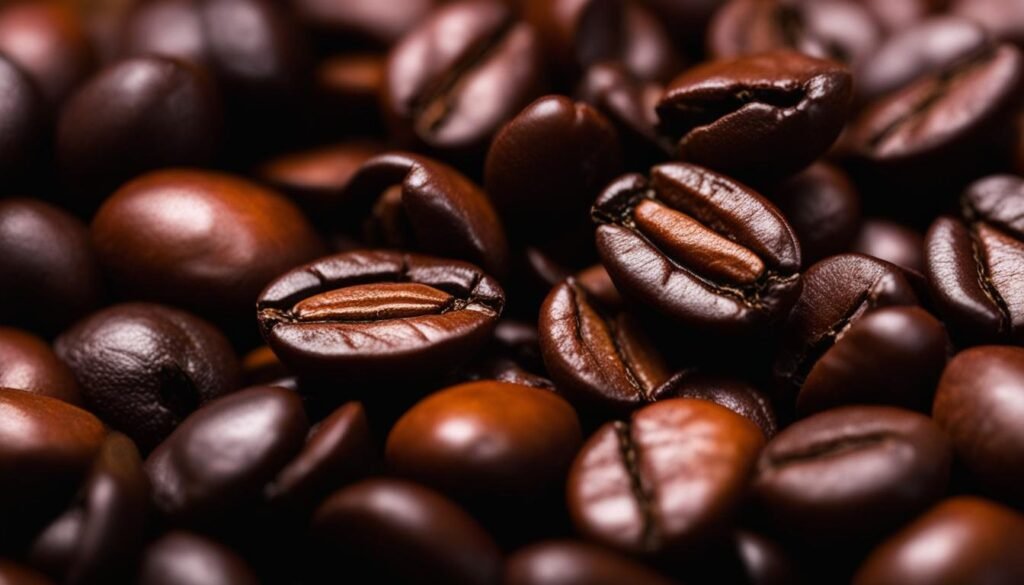Welcome to our exploration of the world of coffee, where we seek to answer the age-old question: which coffee is the strongest? If you’re a coffee lover like us, you’ve probably wondered about the different coffee brands and which one packs the most caffeine punch. In this article, we will delve into the secrets of brewing the strongest coffee and uncover the factors that contribute to its strength and flavor. So grab a cup of your favorite brew, sit back, and join us on this caffeinated journey!
Key Takeaways:
- French press coffee is typically stronger in terms of both caffeine content and flavor compared to other brewing methods.
- The use of coarser grinds, an extended extraction period, and a metal mesh filter contribute to the strength of French press coffee.
- French press coffee offers a rich and full-bodied flavor with an intense aroma.
- Factors such as grind size, coffee-to-water ratio, and brewing time and temperature affect the strength of French press coffee.
- French press coffee is stronger than drip coffee, while espresso has a deeper flavor but can be stronger in caffeine content.
Factors That Affect French Press Coffee Strength
In this section, we will explore the key factors that contribute to the strength of French press coffee. Understanding these factors will help you brew a flavorful and robust cup of coffee every time.
Coarser Grinds
One of the main reasons why French press coffee is stronger is the use of coarser grinds. Unlike other brewing methods that require finer grinds, French press coffee calls for a coarser grind size. The larger coffee particles allow for a more efficient extraction process, resulting in a stronger and more full-bodied cup of coffee.
Extended Extraction Period
The extended extraction period is another factor that contributes to the strength of French press coffee. When brewing with a French press, the coffee grounds are steeped in hot water for a longer duration compared to other methods. This prolonged contact between the grounds and water leads to a fuller extraction of flavors and oils, creating a bolder and more intense cup of coffee.
Metal Mesh Filter
The metal mesh filter used in a French press plays a crucial role in enhancing the strength of the coffee. Unlike paper filters, the metal mesh filter allows for the passage of more coffee particles and natural oils into the brewed coffee. This results in a richer and more flavorful cup of coffee, making French press coffee a popular choice for coffee enthusiasts seeking a stronger brew.
Table: Factors That Affect French Press Coffee Strength
| Factors | Description |
|---|---|
| Coarser Grinds | The use of coarser grinds allows for a more efficient extraction process, resulting in a stronger cup of coffee. |
| Extended Extraction Period | The longer steeping time in a French press leads to a fuller extraction of flavors and oils, contributing to a bolder cup of coffee. |
| Metal Mesh Filter | The metal mesh filter allows for the passage of more coffee particles and natural oils, enhancing the richness and flavor of the coffee. |
Taste and Flavor Profile of French Press Coffee

French press coffee is known for its rich and full-bodied flavor that tantalizes the taste buds. The brewing method used in a French press allows for a more intense extraction of flavors and aromas from the coffee beans, resulting in a truly satisfying experience. With each sip, you’ll be greeted by the deep and robust character of the coffee.
Alongside its exceptional flavor, French press coffee offers an intense aroma that fills the room and awakens the senses. The combination of freshly ground beans and the gentle immersion brewing process produces an enticing fragrance that is sure to captivate coffee lovers.
When it comes to the taste profile, it’s important to note that French press coffee can exhibit a certain level of bitterness and acidity. This is due to the prolonged contact between the coffee grounds and water during the brewing process. However, by adjusting the brewing time and water temperature, you can find the perfect balance to suit your preferences.
| Taste Profile | Description |
|---|---|
| Rich and full-bodied flavor | French press coffee boasts a robust and fulfilling taste that lingers on the palate. |
| Intense aroma | The aromatic notes of French press coffee are captivating and invigorating. |
| Bitterness and acidity | French press coffee may have a pronounced bitterness and acidity, which can be balanced through brewing adjustments. |
Brewing Method and Techniques for French Press Coffee

When it comes to brewing French press coffee, the grind size and consistency, coffee-to-water ratio, and brewing time and temperature all play key roles in determining the strength and flavor profile of the final cup. Let’s take a closer look at each of these factors:
Grind Size and Consistency
The grind size and consistency of the coffee beans used in a French press are crucial for achieving optimal extraction and a strong cup of coffee. A coarse grind allows for slower extraction, which results in a bolder flavor. It also helps to prevent over-extraction, which can lead to bitterness. On the other hand, grinding the beans too fine can result in a muddy cup of coffee with excessive sediment.
Coffee-to-Water Ratio
The coffee-to-water ratio in a French press is another important factor that affects the strength of the brew. Generally, a ratio of 1:15 to 1:17 is recommended, which means using 1 part coffee to 15-17 parts water by weight. Adjusting the ratio can help in customizing the strength according to personal preferences.
Brewing Time and Temperature
The brewing time and temperature also contribute to the strength and flavor of French press coffee. The ideal brewing temperature is between 195°F and 205°F (90°C and 96°C). As for the brewing time, a general guideline is to steep the coffee for 4-5 minutes before pressing the plunger. However, depending on the desired strength, the brewing time can be adjusted to suit individual preferences.
By carefully considering these factors and experimenting with different combinations, you can achieve the perfect cup of strong and flavorful French press coffee.
| Grind Size | Strength | Flavor Profile |
|---|---|---|
| Coarse | Strong | Bold, full-bodied |
| Medium | Moderate | Balanced, smooth |
| Fine | Weak | Delicate, subtle |
Comparing French Press to Other Brewing Methods
When it comes to brewing coffee, there are several methods to choose from, each with its own unique characteristics. Let’s explore how French press coffee compares to other popular brewing methods: drip coffee, espresso, pour-over, and cold brew.
Drip Coffee:
Drip coffee is one of the most common methods used to brew coffee. It involves pouring hot water over ground coffee beans and allowing it to slowly drip through a filter. This method produces a smooth and clean cup of coffee. However, compared to French press coffee, drip coffee may lack the intensity and boldness of flavor that many coffee enthusiasts crave.
Espresso:
Espresso is a concentrated form of coffee that is brewed by forcing hot water through finely ground coffee under high pressure. It results in a rich and intense flavor with a layer of crema on top. While espresso has a more robust flavor profile compared to French press coffee, it is typically served in smaller quantities due to its high caffeine content.
Pour-Over:
Pour-over coffee is made by slowly and precisely pouring hot water over freshly ground coffee beans placed in a filter. This method allows for more control over the brewing process and results in a clean and crisp cup of coffee. The flavor of pour-over coffee is often delicate and nuanced, offering a different experience compared to the bolder flavors of French press coffee.
Cold Brew:
Cold brew coffee is made by steeping ground coffee in cold water for an extended period, usually overnight. This method produces a smooth and mellow cup of coffee with lower acidity and bitterness. Cold brew coffee is often preferred by those who enjoy a refreshing and less acidic taste. It offers a unique alternative to the strong and robust flavors of French press coffee.
| Brewing Method | Strength | Flavor Profile |
|---|---|---|
| Drip Coffee | Moderate | Smooth, clean |
| Espresso | High | Rich, intense |
| Pour-Over | Moderate | Delicate, nuanced |
| Cold Brew | Low | Smooth, mellow |
Factors Affecting French Press Coffee Strength

When it comes to making a strong cup of French press coffee, several factors come into play. The quality of the coffee itself is of utmost importance. Using freshly roasted beans from high-quality sources ensures that you’ll be starting with a strong foundation. Additionally, the grind size and consistency are crucial in determining the strength of your brew. A coarser grind allows for a slower extraction process, resulting in a bolder and more robust cup of coffee.
The water temperature used during brewing also contributes to the strength of the coffee. Hot water, typically around 195°F to 205°F, helps extract more flavors and compounds from the coffee grounds, resulting in a stronger brew. However, it is essential to avoid boiling water as it can scorch the coffee and lead to a bitter taste.
Finally, the brew time plays a significant role in the strength of French press coffee. Allowing the coffee to steep for a longer period can lead to a more intense and full-bodied cup. It’s recommended to brew French press coffee for around four to five minutes, but you can adjust the brew time according to your taste preferences.
Factors Affecting French Press Coffee Strength:
- Coffee quality: Choose freshly roasted beans from high-quality sources.
- Grind size and consistency: Opt for a coarser grind to achieve a bolder flavor.
- Water temperature: Use hot water between 195°F to 205°F for optimal extraction.
- Brew time: Steep the coffee for around four to five minutes for a stronger cup.
In conclusion, achieving a strong French press coffee requires attention to detail and the right combination of factors. By starting with high-quality coffee beans, using a coarser grind, selecting an appropriate water temperature, and adjusting the brew time, you can create a robust and flavorful cup of coffee that satisfies even the strongest caffeine cravings.
The Truth about Robusta Coffee
When it comes to coffee, there is often a debate between Robusta and Arabica. These two types of coffee beans have distinct characteristics that set them apart. Let’s take a closer look at the truth about Robusta coffee and how it compares to Arabica in terms of caffeine content, taste and flavor profile, price and quality, and coffee production.
Caffeine Content
One of the main differences between Robusta and Arabica coffee is the caffeine content. Robusta beans contain about twice as much caffeine as Arabica beans. This higher caffeine content gives Robusta coffee a stronger, more bitter taste and a more pronounced kick. If you’re looking for a coffee that will give you a boost of energy, Robusta is the way to go.
Taste and Flavor Profile
As mentioned earlier, Robusta coffee has a stronger, more bitter taste compared to Arabica. It also tends to have a less complex flavor profile with fewer notes of acidity and sweetness. Some coffee enthusiasts may find the boldness and intensity of Robusta coffee appealing, while others may prefer the smoother and more nuanced flavors of Arabica coffee.
Price and Quality
In general, Robusta coffee is considered to be of lower quality compared to Arabica. This is partly due to the fact that Robusta beans are easier to cultivate and are more resistant to pests and diseases. As a result, Robusta coffee is often priced lower than Arabica. However, it’s important to note that there are high-quality Robusta beans available, especially those that are carefully cultivated and processed.
Coffee Production
Robusta coffee is primarily grown in lower altitude regions, such as Vietnam, Indonesia, and Brazil. These areas provide the ideal climate and environment for Robusta beans to thrive. The beans are harvested using various methods and are often used in espresso blends and instant coffee production. Arabica coffee, on the other hand, is typically grown at higher altitudes and is known for its delicate flavors and aromas.
| Comparison | Robusta | Arabica |
|---|---|---|
| Caffeine Content | Higher | Lower |
| Taste and Flavor Profile | Bold and bitter | Complex and nuanced |
| Price and Quality | Lower | Higher |
| Coffee Production | Lower altitude regions | Higher altitude regions |
In conclusion, Robusta coffee offers a stronger caffeine kick and a bolder taste compared to Arabica. However, it is often considered of lower quality and is priced lower as well. Ultimately, the choice between Robusta and Arabica comes down to personal preference and taste preferences. Whether you prefer the boldness of Robusta or the complexity of Arabica, there is a coffee out there for everyone.
Growing and Processing Robusta Coffee

When it comes to growing and processing Robusta coffee, certain factors contribute to the unique characteristics of this coffee variety. Let’s explore the regions and climate where Robusta thrives, the importance of altitude and environment, the challenges of pests and diseases, and the methods used for harvesting and processing.
Growing Regions and Climate
Robusta coffee is primarily cultivated in the lower altitude regions of Southeast Asia and Africa. These areas provide the ideal climate for Robusta plants to thrive, with hot temperatures and ample sunshine. The regions known for producing Robusta coffee include Vietnam, Indonesia, and Brazil.
Altitude and Environment
Unlike Arabica coffee, which grows at higher altitudes, Robusta is more resilient and adapted to lower altitudes. The lower altitude regions where Robusta is cultivated offer a diverse and favorable environment for the plants to flourish. This environment plays a crucial role in shaping the flavor profile of Robusta coffee.
Pests and Diseases
One of the advantages of Robusta coffee is its natural resistance to pests and diseases. Compared to Arabica coffee, Robusta plants are hardier and less susceptible to infestations and infections. This resilience reduces the need for extensive pesticide use, making Robusta cultivation more sustainable.
Harvesting and Processing Methods
Robusta coffee beans are harvested by hand or using mechanical methods, depending on the scale of production. The harvested cherries undergo various processing methods such as wet hulling, natural drying, or semi-washed processing. These methods further enhance the unique flavor profiles of Robusta coffee.
| Factors | Details |
|---|---|
| Growing Regions and Climate | Lower altitude regions of Southeast Asia and Africa, hot temperatures, ample sunshine |
| Altitude and Environment | Lower altitudes, diverse and favorable environment |
| Pests and Diseases | Natural resistance, reduced pesticide use |
| Harvesting and Processing | Hand-picked or mechanical harvesting, various processing methods |
Brewing and Roasting Robusta Coffee

When it comes to brewing and roasting Robusta coffee, there are various techniques and methods that can be used to enhance its unique flavor profiles. In this section, we will explore the different roasting techniques, brewing methods, and the role of espresso in Italian tradition.
Roasting Techniques
Robusta coffee can be roasted using different techniques to achieve desired flavors. One common method is dark roasting, which brings out the bold and intense flavor profile of Robusta beans. Dark roast beans are roasted at higher temperatures and for a longer duration, resulting in a deep, smoky taste. Light and medium roasts are also options for those who prefer a milder flavor with more pronounced acidity.
Brewing Methods
Robusta coffee can be brewed using various methods to extract its unique characteristics. Drip brewing, one of the most popular methods, involves pouring hot water over a filter that contains ground coffee. This method retains the coffee’s natural oils and flavors, resulting in a well-balanced cup. French press brewing, with its longer extraction time and immersion method, brings out the full-bodied nature of Robusta coffee, offering a rich and robust taste.
Espresso and Italian Tradition
Robusta coffee plays a significant role in Italian espresso tradition. Espresso is a concentrated form of coffee that is brewed using high pressure and finely ground beans. Robusta coffee, with its higher caffeine content and strong flavor, is often blended with Arabica beans to create espresso blends. This combination results in a balanced and flavorful espresso shot that is enjoyed by coffee lovers worldwide.
Table: Comparison of Roasting Techniques and Brewing Methods
| Roasting Techniques | Brewing Methods |
|---|---|
| Dark Roast | Espresso |
| Light Roast | Drip Brewing |
| Medium Roast | French Press |
Notable Robusta Varieties and Creating Coffee Blends
Robusta coffee, known for its higher caffeine content and stronger, more bitter taste, comes in various notable varieties that contribute to the diversity of coffee blends. These Robusta varieties, when skillfully blended with other coffee beans, can enhance the strengths and balance the weaknesses of the resulting brew.
One notable Robusta variety is the Parchment Robusta, which is characterized by its unique parchment-like texture and earthy flavor profile. This variety is often used in blends to add body and depth to the coffee, enhancing its overall strength and robustness.
Another popular Robusta variety is the Chariot Robusta, which is known for its bold and rich flavors, featuring notes of chocolate and spices. Blending Chariot Robusta with other coffee beans can create a complex and distinctive brew, with intensified strength and a lingering finish.
| Robusta Variety | Characteristics | Flavor Profile |
|---|---|---|
| Parchment Robusta | Unique parchment-like texture | Earthy |
| Chariot Robusta | Bold and rich flavors | Chocolate and spices |
Creating coffee blends involves a meticulous selection of beans and precise ratio adjustments to achieve the desired strength and flavor profile. Blending Robusta with Arabica beans, for example, can result in a well-balanced brew with a smooth body and hints of bitterness. The higher caffeine content of Robusta can also contribute to the overall strength of the blend.
Whether it’s the inclusion of a specific Robusta variety or the artful combination of different coffee beans, creating coffee blends allows for an endless exploration of flavors, strengths, and aromatic complexities. The skillful craftsmanship behind these blends ensures that coffee enthusiasts can enjoy a diverse and satisfying range of coffee experiences.
The Relationship Between Roast and Caffeine Levels

When it comes to coffee, the roast level of the beans can have a significant impact on both the caffeine content and the taste and flavor profile. While many believe that darker roasts contain less caffeine, the truth is that the difference in caffeine levels between dark and light roasts is minimal.
In terms of taste and flavor, lighter roasts tend to have a brighter and more acidic profile, while darker roasts offer a bolder and more robust flavor. The choice between light and dark roast is a matter of personal preference, as each roast level brings out unique characteristics in the coffee beans.
Table: Caffeine Content by Roast Level
| Roast Level | Caffeine Content |
|---|---|
| Light Roast | Approximately 95 mg per 8 oz cup |
| Medium Roast | Approximately 100 mg per 8 oz cup |
| Dark Roast | Approximately 95 mg per 8 oz cup |
While caffeine content may vary slightly depending on the bean variety and brewing method, this table provides a general guideline for understanding the caffeine levels in different roast levels. It is important to note that the way coffee is brewed and the serving size also impact the overall caffeine intake.
In addition to caffeine levels, the roast level also affects the health benefits of coffee. Dark roast coffee has been found to contain higher levels of antioxidants, which have been associated with various health benefits, including reduced risk of certain diseases.
Conclusion
After exploring the various factors that contribute to the strength of coffee, we can conclude that French press coffee is typically considered stronger in terms of both flavor and caffeine content compared to other brewing methods. French press achieves this through the use of coarser grinds, an extended extraction period, and a metal mesh filter, allowing for a more effective extraction of the coffee’s natural flavors and oils.
However, it is important to note that determining the “strongest” coffee ultimately depends on individual taste preferences and caffeine needs. The strength of coffee can be influenced by factors such as the brewing method, coffee-to-water ratio, and roast level. Experimenting with these elements allows us to customize our coffee’s strength and flavor profile to our liking.
So, the next time you’re wondering which coffee is the strongest, remember that it’s a combination of factors that determine the answer. French press coffee may be a good starting point, but there are other brewing methods and coffee blends that can offer different taste and flavor profiles. Explore and find the coffee that suits your preferences, whether it’s the rich and robust flavor of French press or the unique characteristics of other brewing methods. Ultimately, the choice is yours.
FAQ
Which brewing method produces the strongest coffee?
French press coffee is typically considered stronger in terms of both flavor and caffeine content compared to other brewing methods.
What factors contribute to the strength of French press coffee?
The use of coarser grinds, an extended extraction period, and the metal mesh filter in a French press all contribute to the strength of the coffee.
What is the taste and flavor profile of French press coffee?
French press coffee is known for its rich and full-bodied flavor, as well as its intense aroma. However, it can be stronger in terms of bitterness and acidity due to the prolonged contact between the coffee grounds and water.
What brewing techniques can be used to adjust the strength of French press coffee?
Factors such as grind size and consistency, coffee-to-water ratio, and brewing time and temperature can be adjusted to customize the strength and flavor profile of French press coffee.
How does French press coffee compare to other brewing methods in terms of strength?
French press coffee is stronger than drip coffee due to the use of a metal mesh filter, which allows for more oils and flavor compounds to pass through. However, espresso has a deeper and more intense flavor compared to French press coffee.
What factors affect the strength of French press coffee?
The quality of the coffee beans used, grind size and consistency, water temperature, and brew time all contribute to the strength of French press coffee.
What are the differences between Robusta and Arabica coffee?
Robusta coffee has a higher caffeine content and a stronger, more bitter taste compared to Arabica coffee. It is also generally considered lower in quality and priced lower.
How is Robusta coffee grown and processed?
Robusta coffee is primarily grown in lower altitude regions of Southeast Asia and Africa. It is more resistant to pests and diseases and is harvested and processed using various methods, including wet hulling.
How is Robusta coffee brewed and roasted?
Robusta coffee can be brewed using various methods, including drip brewing, French press, cold brew, and espresso. It can also be roasted using different techniques to bring out its unique flavor profiles.
What are the different blends and varieties of Robusta coffee?
Robusta coffee comes in different varieties and is often blended with other coffee beans to enhance its strengths and balance its weaknesses.
How does roast level affect the caffeine levels of coffee?
Darker roasts generally have slightly less caffeine than lighter roasts, although the difference is minimal.
Which coffee is the strongest?
The strength of coffee is influenced by various factors, and it ultimately depends on personal taste preferences. French press coffee is typically considered stronger in terms of both flavor and caffeine content compared to other brewing methods.

Leave a Reply